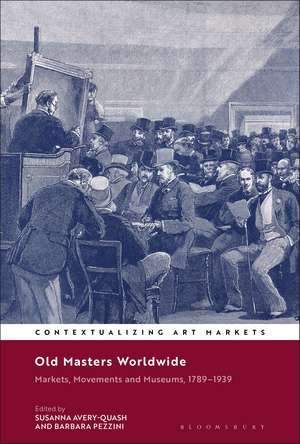Old Masters Worldwide: Markets, Movements and Museums, 1789–1939: Contextualizing Art Markets
Editat de Dr Susanna Avery-Quash, Dr. Barbara Pezzinien Limba Engleză Paperback – 18 mai 2022
| Toate formatele și edițiile | Preț | Express |
|---|---|---|
| Paperback (1) | 200.00 lei 6-8 săpt. | |
| Bloomsbury Publishing – 18 mai 2022 | 200.00 lei 6-8 săpt. | |
| Hardback (1) | 705.40 lei 3-5 săpt. | +25.74 lei 7-13 zile |
| Bloomsbury Publishing – 11 noi 2020 | 705.40 lei 3-5 săpt. | +25.74 lei 7-13 zile |
Preț: 200.00 lei
Preț vechi: 259.08 lei
-23% Nou
Puncte Express: 300
Preț estimativ în valută:
38.27€ • 39.96$ • 31.67£
38.27€ • 39.96$ • 31.67£
Carte tipărită la comandă
Livrare economică 05-19 aprilie
Preluare comenzi: 021 569.72.76
Specificații
ISBN-13: 9781350283633
ISBN-10: 1350283630
Pagini: 320
Ilustrații: 87 bw illus
Dimensiuni: 156 x 234 mm
Greutate: 0.45 kg
Editura: Bloomsbury Publishing
Colecția Bloomsbury Visual Arts
Seria Contextualizing Art Markets
Locul publicării:London, United Kingdom
ISBN-10: 1350283630
Pagini: 320
Ilustrații: 87 bw illus
Dimensiuni: 156 x 234 mm
Greutate: 0.45 kg
Editura: Bloomsbury Publishing
Colecția Bloomsbury Visual Arts
Seria Contextualizing Art Markets
Locul publicării:London, United Kingdom
Caracteristici
Offers a first comprehensive study of the origins, development and rise of the Old Master market in Europe and beyond
Notă biografică
Susanna Avery-Quash is Senior Research Curator (History of Collecting) at the National Gallery, UK, where she is responsible for activities associated with the Gallery's research strand 'Buying, Collecting and Display'. Her recent publications concerning the history of collecting and the art market include three co-edited volumes which each appeared in 2019: London and the Emergence of a European Art Market, 1780-1820, The Georgian London Town House: Building, Collecting and Display and Leonardo in Britain: Collections and Reception History.Barbara Pezzini is an art and cultural historian who has written extensively on European Old Masters and British art of the period 1830-1970. Barbara has previously worked as Editor of Visual Resources and in curatorial, research and archival projects for the National Gallery, National Trust, Burlington Magazine and the Art UK Sculpture Project.
Cuprins
List of FiguresSeries Editor's IntroductionForeword, Gabriele Finaldi (National Gallery, UK)AcknowledgementsList of Abbreviations Introduction, Susanna Avery-Quash (National Gallery, UK) and Barbara Pezzini (Independent Scholar, UK)Part I: Developing European Networks, 1780-18941.The European Market for Italian Old Masters after Napoleon, Robert Skwirblies (Technische Universität Berlin, Germany)2. Old Masters from Rome to London: Alexander Day and Pietro Camuccini, Pier Ludovico Puddu (Palacký University, Czech Republic)3. Selling Old Masters in Britain, France and the Netherlands: The Networking Strategies of John Smith, Julia I. Armstrong-Totten (Independent Scholar, USA)4. A Web of Agents: Buying Old Masters for the National Gallery, London, Susanna Avery-Quash (National Gallery, UK)Part II: Gaining International Visibility and Expertise, 1850-19095. Old Masters versus Modern Art in Parisian Auctions, Léa Saint-Raymond (Université Paris Nanterre, France)6. Agnew's from Modern Art to the Old Masters, Barbara Pezzini (Independent Scholar, UK)7. Taste or Opportunity? Durand-Ruel and Spanish Old Masters, Véronique Gerard Powell (Independent Scholar, France)8. Authority and Expertise in the Old Master Market: Bode and Duveen, Catherine B. Scallen (Case Western Reserve University, USA)9. Scholar, Dealer and Museum Man: Robert Langton Douglas in the International Old Master Market, Imogen Tedbury (Royal Holloway, University of London, UK)Part III: Casting a Wider Web, 1900-1939 10. A Missed Opportunity? Goupil and the Old Masters, Agnès Penot (Independent Scholar, USA)11. Knoedler and Old Masters in America, Inge Reist (The Frick Collection, USA)12. Trust, Friendship and Politics in the Old Master Market: Duveen and the State Art Collection of the Kingdom of Yugoslavia, Jelena Todorovic (Faculty of Fine Arts, Serbia)13. Negotiating Old Masters for the Melbourne National Gallery, Monique Webber (The University of Melbourne, Australia and Monash University Art Design and Architecture, Australia)14. The Distant Old Masters of South Africa, Jillian Carman (University of the Witwatersrand, South Africa)Select BibliographyAuthor BiographiesIndex
Recenzii
How did Old Master paintings-once feared to be tainted by unscrupulous copies and dubious attributions-come to hold such a prized pride of place in private collections and museums? This fascinating collection, full of fresh research and exciting archival discoveries, reveals a complex network of dealers, agents, and collectors at work over the turbulent decades from the French Revolution to the Great Depression, developing new modes of authoritative expertise and adopting shrewd strategies in order to render the Old Master market into a global business.
An urgently needed study which brings together an impressive range of international scholarship to illuminate the history of a central element of the secondary art market. This volume carefully delineates the genealogy and subsequent development of the market for Old Master paintings in all its vibrant complexity, mapping out key aspects of the market in a variety of international contexts and highlighting the networks, actors and practices in its evolving ecology. It is essential reading for anyone studying the history of the art market.
An urgently needed study which brings together an impressive range of international scholarship to illuminate the history of a central element of the secondary art market. This volume carefully delineates the genealogy and subsequent development of the market for Old Master paintings in all its vibrant complexity, mapping out key aspects of the market in a variety of international contexts and highlighting the networks, actors and practices in its evolving ecology. It is essential reading for anyone studying the history of the art market.













